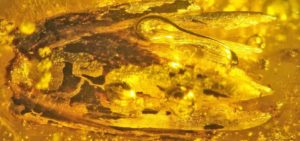
Amber research by the Oregon State University College of Science has produced the first definite identification of grass in fossilized tree resin from the Baltic region, home to the world’s most well-known amber deposits.
The specimen studied by George Poinar Jr., named Eograminis balticus, also represents the first fossil member of Arundinoideae, a subfamily of the widespread Poaceae family that includes cereal grasses, bamboos and many species found in lawns and natural grasslands.
Findings, now in preprint, will be published in the International Journal of Plant Sciences.
Blown or shoved against a resin-producing tree, the fossil grass lost one of its spikelets some 40 or 50 million years ago, along with an accompanying insect that had been feeding on it.
A spikelet is one unit of inflorescence, or flower arrangement, and consists of two glumes and one or more florets. A glume is a leaflike structure below the flower cluster, and a floret is one of the small flowers in the cluster.
The fossil spikelet is the first definite evidence that grasses were among the various plants in the Baltic amber forest.
“The discovery not only adds a new plant group to the extensive flora that have been described from Baltic amber but provides new insights into the forest habitat the amber came from, a controversial topic in this field of study,” said Poinar, an international expert in using plant and animal life forms preserved in amber to learn more about the biology and ecology of the distant past.
Poinar says some scientists have proposed that fossiliferous amber from the Baltic region was formed in tropical and subtropical woods, and others say it came from a humid, marshy, warm-temperate forest.
“Our new grass suggests that for at least a time the habitat was warm-temperate, like you see today in mixed deciduous and conifer forests,” said Poinar, who collaborated on the study with Roberg Soreng of the Smithsonian Institution. “Present on the spikelet is an immature grasshopper-like insect and a leaf-spot fungal spore that provide information on the microhabitat of the fossil grass. The spikelet has structural and developmental features that existed in early Cenozoic grasses and establishes an important calibration point for future studies on the origin and splitting of genera in its subtribe.”
Because of the excellent preservation of the spikelet, observations could be made under direct light with both stereoscopic and compound microscopes, Poinar said.
“The spikelet has some features of members of the extant wetland genus Molinia in the tribe Molinieae, subtribe Moliniinae,” Poinar said. “Molinia species are concentrated around the Baltic Sea, but some of those species’ characteristics are different from what we see in this fossil.”
Informally known as moor grass, Molinia is a wetland genus. In addition to the Baltic region, Molinia is found in sand in habitats ranging from coastal to subalpine, and in fens and sphagnum bogs in forests. A fen is a peat-accumulating wetland that is fed by surface or ground water rich in minerals.
The Eograminis balticus spikelet specimen originated from the Samland Peninsula in the Kalinin District of the Russian Federation, Poinar said.
The name of the genus derives from the Latin words for age (aeon) and grass (graminis).
Reference:
George Poinar, Robert J. Soreng. A New Genus and Species of Grass, Eograminis balticus (Poaceae: Arundinoideae), in Baltic Amber. International Journal of Plant Sciences, 2021; 000 DOI: 10.1086/716781
Note: The above post is reprinted from materials provided by Oregon State University. Original written by Steve Lundeberg.










